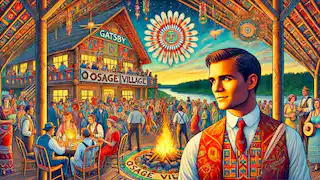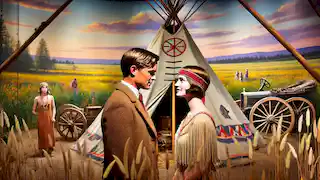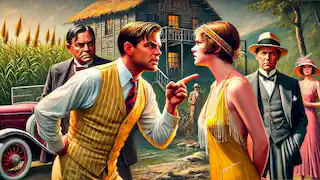Chapter 1: The Arrival
In the quiet expanse of the Oklahoma plains, there lay a village where the Osage tribe resided. The earth was their home, the sky their roof, and the stars their guide. Among the many stories that echoed through the canyons and whispered in the winds, one stood out – the tale of a man known simply as Gatsby.
Nick Carraway, a young man of mixed heritage, returned to the village after years of education in the East. He sought solace and understanding, away from the bustle of the cities, back to the simplicity of his ancestral roots. His family’s teepee stood modestly by the river, a testament to their enduring connection to the land.
Nick's cousin, Daisy, a woman of captivating beauty and grace, lived in a nearby village. She was married to Tom Buchanan, a man of great wealth and influence, whose arrogance was as vast as the plains themselves. Their relationship, marred by Tom’s frequent infidelities and violent tendencies, left Daisy in a state of perpetual sadness, her laughter a mere echo of what it once was.
Nick settled into his new life, reconnecting with his roots and the people of the village. It wasn’t long before he heard whispers of a man named Gatsby. This enigmatic figure had recently arrived, building a large and extravagant lodge by the river. His gatherings were legendary, filled with laughter, music, and the finest food, attracting people from all around.
The first time Nick saw Gatsby was during one of his famous gatherings. The lodge was a marvel, decorated with intricate carvings and paintings that told stories of old. The scent of roasted venison and freshly baked bread filled the air, mingling with the sound of drums and flutes. Gatsby himself was a sight to behold. Tall and handsome, with eyes that seemed to hold the wisdom of the ages, he moved through the crowd with ease and grace. Despite his affluence and charm, there was a melancholy that clung to him, a sadness that no amount of wealth or admiration could erase.
Intrigued, Nick found himself drawn to Gatsby, and over the course of the evening, they spoke. Gatsby spoke of his journey, of the battles he fought and the lands he traversed. He was a man of mystery, his past a tapestry of half-truths and legends.
“Why did you come here?” Nick asked.
Gatsby’s eyes, reflecting the light of the fire, seemed distant. “I came for a dream,” he replied, “a dream of love and belonging.”
As the night wore on, Nick learned more about Gatsby’s past. Born to humble beginnings, Gatsby had amassed his wealth through means shrouded in secrecy. Some said he discovered gold; others whispered of more nefarious dealings. But what was clear was that Gatsby’s heart belonged to one woman – Daisy.
Chapter 2: The Legend of Gatsby
Gatsby’s love for Daisy was a flame that refused to die, even after years apart. They had met long ago, during one of Gatsby’s travels. Daisy, captivated by his spirit and ambition, fell deeply in love. But societal pressures and her family's expectations led her to marry Tom Buchanan, a decision that haunted her ever since.
Nick, sympathetic to Gatsby’s plight, agreed to help him reconnect with Daisy. They arranged a meeting at Nick’s teepee, a place where Daisy could feel safe and at ease.

When Daisy arrived, her beauty was as striking as ever. Her eyes, filled with curiosity and nostalgia, met Gatsby’s, and for a moment, time seemed to stand still. The years melted away, and they were once again the young lovers who dreamed of a future together.
Gatsby and Daisy spent hours talking, reminiscing about the past and imagining a future where they could be together. But reality was never far behind. Daisy’s loyalty to her family and her fear of societal judgment loomed over them like a dark cloud.
As the days turned into weeks, Gatsby and Daisy’s secret meetings continued. They met by the river, under the ancient oak trees, where they could speak freely and dream without restraint. Gatsby’s lodge, once a place of grand celebrations, now served as a sanctuary for their love. It was here that they felt the world’s pressures the least, wrapped in each other’s arms, sharing whispered promises of a future together.
Yet, the more time they spent together, the more the village began to take notice. Rumors spread like wildfire, and the villagers, though intrigued, were cautious. They saw the growing bond between Gatsby and Daisy and wondered how long it would be before Tom Buchanan discovered the truth.
Chapter 3: The Conflict
As Gatsby and Daisy grew closer, Tom Buchanan began to suspect that something was amiss. His pride and arrogance couldn’t tolerate the thought of losing Daisy, not to a man he deemed inferior. Tom’s wealth and power were his shields, and he wielded them without mercy.
Tom confronted Gatsby, challenging him in front of Daisy and Nick. The confrontation was fierce, with Tom belittling Gatsby’s origins and questioning the legitimacy of his wealth. Gatsby, though visibly hurt, stood his ground, his love for Daisy giving him strength.

Daisy, torn between her love for Gatsby and her loyalty to Tom, was paralyzed by fear and indecision. The tension reached its peak, and Daisy fled, leaving the men to their feud.
The confrontation left Gatsby heartbroken but undeterred. He was determined to show Daisy that they could have a life together, free from the constraints of her current marriage. Gatsby began to plan a new future, one where he and Daisy could live openly, without fear or judgment. He envisioned a life where their love was not hidden but celebrated, where they could build a home together and raise a family.
However, Tom Buchanan was not a man to be easily thwarted. He used his influence to turn the village against Gatsby, spreading lies and sowing seeds of doubt. Tom’s wealth and status gave him power, and he wielded it ruthlessly. The villagers, unsure of what to believe, began to distance themselves from Gatsby, leaving him increasingly isolated.
Nick, caught in the middle, tried to reason with both sides. He saw the genuine love between Gatsby and Daisy and believed that they deserved a chance to be happy. But he also understood the complexity of their situation and the societal pressures that weighed heavily on Daisy.
Chapter 4: Love and Loss
The summer was drawing to a close, and the atmosphere in the village grew tense. The once lively gatherings at Gatsby’s lodge became somber affairs, as rumors of his feud with Tom spread.
One fateful evening, tragedy struck. Gatsby, still clinging to the hope that Daisy would choose him, waited by the river for a sign. But what he received was far from what he hoped for. A group of men, loyal to Tom and eager to protect his honor, ambushed Gatsby. In the ensuing struggle, Gatsby was gravely injured.

Nick, hearing the commotion, rushed to Gatsby’s side. He held his friend’s hand as the life slowly ebbed from his body. Gatsby’s last words were of Daisy, his dream of a life with her remaining unfulfilled.
As Gatsby lay dying, he spoke of his love for Daisy and his regret that they never had the chance to live their dream. His eyes, once filled with hope and determination, now held a deep sorrow. He whispered to Nick, “Tell her I never stopped loving her. Tell her my dream was always of her.”
Nick promised to deliver Gatsby’s final message, his heart heavy with grief. He watched as the light in Gatsby’s eyes dimmed, feeling the weight of the loss deeply. Gatsby’s death marked the end of an era, the shattering of a dream that had been so close to becoming a reality.
Chapter 5: The Aftermath
The news of Gatsby’s death spread quickly through the village. The once grand lodge now stood silent, a monument to a dream lost. Daisy, consumed by guilt and sorrow, withdrew from the world, her laughter gone forever.
Nick, heartbroken and disillusioned, decided to leave the village. The land that once brought him solace now held memories too painful to bear. He returned to the East, carrying with him the story of Gatsby, a story of love, ambition, and the relentless pursuit of a dream.

Years later, Nick would recount the tale of Gatsby to anyone who would listen. He spoke of the man who dared to dream, who loved deeply and lived passionately, and whose life was a testament to the enduring power of hope.
Daisy, unable to reconcile her feelings, lived a life of quiet desperation. She remained with Tom, but their marriage was a hollow shell, devoid of the love and passion that once filled it. Daisy often visited the river where she and Gatsby had spent so many cherished moments, her heart aching with the memory of what could have been.
Tom Buchanan, having secured his place of power, continued his life much as before. Yet, even he could not escape the shadow of Gatsby’s legacy. The villagers, though outwardly supportive of Tom, never forgot the tragedy that unfolded. Gatsby’s story became a cautionary tale, a reminder of the fragility of dreams and the consequences of unchecked ambition.
Nick, now an older man, found solace in sharing Gatsby’s story. He traveled from village to village, his words painting a vivid picture of the man he once called a friend. He spoke of Gatsby’s unwavering hope, his relentless pursuit of a dream, and the love that defined his life. Nick’s storytelling kept Gatsby’s memory alive, ensuring that his legacy would not be forgotten.
As Nick recounted the tale, he often reflected on the lessons he learned from Gatsby. He realized that while dreams are powerful,
they must be tempered with reality. The pursuit of a dream can inspire greatness, but it can also lead to one’s downfall if not balanced with wisdom and understanding. Nick hoped that by sharing Gatsby’s story, others would be inspired to dream boldly but also to live with their eyes open to the world around them.



















